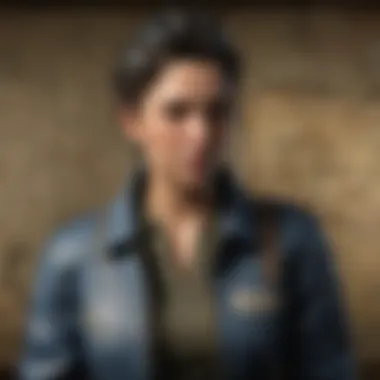The Art of Farewell: Crafting Meaningful Goodbye Letters


Intro
Goodbye letters are a unique form of communication, serving as both a bridge between connections and a poignant farewell. They hold emotional weight and necessary closure for people who are moving on from a specific phase in their lives. Writing such letters can be challenging and fraught with uncertainty. However, a well-crafted goodbye letter can articulate complex feelings into sincere and lasting memories. This article aims to demystify the writing of goodbye letters, offering insights into the reasons one might write such a letter and practical approaches to doing so effectively.
Understanding the emotional significance of goodbye letters can alter the way we express ourselves during moments of change. Each letter captures a unique experience and highlights the varying relational contexts that may shape one’s sentiments.
Exploring the nuances of tone and content based on different situations can help ensure that the message is conveyed in a thoughtful and respected manner. From personal relationships to professional environments, the restructuring of thoughts into a clear narrative will aid in facilitating peace and resolution.
The Role of Goodbye Letters
Goodbye letters play an essential role in communication. They not only help the writer articulate feelings, but they also provide the recipient with a tangible token of the relationship. Over time, these letters may evoke memories and serve as profound reminders of shared experiences.
Emotional Significance
- Closure: Saying goodbye is seldom easy. Individuals often grapple with unresolved emotions when leaving a situation or person behind. A letter brings some closure.
- Expression: Written words can sometimes convey sentiments that are difficult to express face-to-face. Goodbye letters allow for clarifying feelings and expressing appreciation.
- Legacy: They serve as a record of relationships—preserving thoughts and feelings for future reflection.
Context Matters
Regardless of the scenario—be it personal or professional—the context significantly influences tone and content.
- Personal Relationships: Love letters, friendship farewells, or even family goodbyes often hold a more meaningful and emotional charge.
- Professional Environments: These letters may shift to a more formal structure, focusing on gratitude and shared accomplishments while maintaining professionalism.
Understanding these dynamics can guide you in creating a document that resonates with both the writer and recipient. Written well, goodbye letters become timeless artifacts of human connection. They preserve farewells with the compassion and consideration they demand.
Practical Tips for Writing Goodbye Letters
Writing goodbye letters necessitates a thoughtful approach.
- Understand Your Intent: Know precisely why you are writing. Is it closure, gratitude, or nostalgia?
- Choose the Right Tone: Match your letter’s tone to the relationship context. Seek an appropriate balance between formality and personal sentiment.
- Be Genuine: Authenticity adds depth. Share true experiences, feelings, and thoughts.
- Review & Revise: It is essential to refine your message before sending it. Clarity can only enhance the letter's effectiveness.
- Leave it Open: Sometimes, leaving a door slightly ajar can create space for future connections.
Summary
Goodbye letters serve as an important conduit for communication that blends emotional significance with thoughtful expression. They compliment the complexity found in relationships while clarifying the underlying motives for farewells.
This exploration highlights how these letters can effectuate closure and celebrate bonds—be they sentimental, familial, or professional. Readers are encouraged to reflect and craft their own letters thoughtfully, ensuring their unique voices and experiences are evident. Ultimately, the art lies in conveying genuine emotions which carve out meaningful goodbyes, setting the foundation for future encounters or recollections.
Preamble to Goodbye Letters
Goodbye letters hold a unique place in the realm of communication. They encapsulate emotions and are pivotal during transitional life moments. Whether expressing sentiments toward a friend, leaving a job, or marking significant life changes, these letters provide a framework for articulating feelings that might otherwise remain unspoken.
Definition and Purpose
A goodbye letter is more than just a note. It serves various purposes: diminishing sadness, delineating boundaries, or offering a final farewell. Each goodbye letter should reflect the individual relationship and context. Ideally, a good goodbye letter touches on past memories shared, adequately affirms one's decision, and invites further communication if applicable.
Some people may think goodbye letters serve only to express sorrow or regret. However, they also signify new beginnings and present opportunities for gratitude. It allows individuals to process their emotions and can grant closure to both parties involved. Therefore, understanding their definition and purpose is essential for writing a thoughtful letter.
Historical Perspectives
Goodbye letters are not a contemporary phenomenon. For centuries, they have been woven into the fabric of human interaction. From personal correspondence in hand-written letters that men and women exchanged before parting to formal resignation letters in ancient corporate settings, goodbye letters have always played an integral role.
Historically, goodbye letters offered a potent voice to social changes. As people navigated geographical shifts, these letters often chronicled crucial moments in human relationship dynamics. According to various sources, battlefield narrations were at times marked with profound farewells between soldiers and their loved ones.
Furthermore, the rise of digital communication methods has led to evolving forms of goodbye letters. Today, emails and messages on platforms like Facebook and Reddit serve similar functions. These shifts reveal insights about cultural influences on how individuals approach relationships and farewells. Overall, the historical context emphasizes the continuing relevance of goodbye letters in expressing thoughts and leaving lasting impressions on one another.
The Emotional Landscape of Goodbyes
Goodbyes generate complex emotions in many individuals. This emotional landscape is crucial when crafting goodbye letters. Understanding these emotions aids in writing a letter that resonates and provides solace. Goodbye letters not only communicate farewells but also capture the feelings associated with the end of a chapter.
Understanding Grief and Loss


Grief and loss are intertwined concepts often found at the heart of goodbyes. When a person encounters loss, whether through physical departure, relocation, or other forms, they experience a variety of emotions, including sadness, anger, or even confusion. Grief involves a process that each person navigates differently. Raising awareness about the stages of grief—such as denial, anger, bargaining, depression, and acceptance—helps individuals channel their sentiments into a farewell letter.
Writing with an understanding of grief allows for greater empathy. A goodbye letter might reflect a range of feelings, from regret to gratitude. It can also recognize the pain associated with loss. Acknowledging these emotions validates the experience of the recipient and encourages personal healing. Including phrases that express the significance of the bond shared affirms that the relationship was valuable.
Ultimately, phrasing letters with consideration for grief adds a layer of depth. This considerate approach might ask comforting questions or reflect on memories together, helping both parties cope.
Closure as a Vital Process
Closure is vital for personal growth. It allows individuals to process their feelings effectively and move forward. When composing a goodbye letter, it is key to consider closure as an integral part of the communication process. A well-crafted letter fosters closure by providing a sense of finality. It wraps up past interactions in a meaningful way and encourages future reflection.
Goodbye letters can achieve closure by including gratitude, lessons learned, and wishes for the future. Each of these elements ensures that while a chapter ends, it does not erase the experiences shared.
The process of saying goodbye is a shared journey. People crave the ability to tie up loose ends and articulate unspoken thoughts. Creating this space through written communication is invaluable. As readers craft their own goodbyes, they should prioritize these elements to ensure a thorough emotional resolution:
- Recognition of past experiences
- Expression of gratitude
- Hopeful sentiments for future interactions
“Goodbyes are not forever. Goodbyes are not the end. They simply mean I’ll miss you until we meet again.”
Contexts of Goodbye Letters
Understanding the contexts in which goodbye letters are written is crucial. These letters are not merely a formality; they carry emotional weight. Each context brings distinct implications for both the writer and the recipient. A personal farewell addresses deep emotions shaped by memories and experiences. In contrast, professional farewells may focus on career tasks and relationships. Recognizing these nuances helps to craft a letter that fits the situation. The context helps inform the tone, structure, and content of the letter. A thoughtful letter can offer comfort or reassurance, depending on the scenario.
Personal Goodbyes
Personal goodbyes often encompass intense emotions. This type of farewell can stem from significant life changes, like moving away, ending a relationship, or facing a loss. The relationship between the sender and recipient influences the message strongly. When addressing close friends or family, honesty tends to resonate well. Shared experiences often prompt recollections of fond memories and better times. Adding personal anecdotes can enrich these letters and extend emotional support.
However, one must navigate around vulnerability. While sharing feelings is valuable, it is essential to avoid overwhelming the reader. It may help to express sadness but also highlight gratitude for shared experiences. Offering expressions like “I will always cherish our time together” can make the farewell meaningful without venturing into deep sadness.
Professional Farewells
In a professional setting, goodbye letters often serve a functional purpose. Many times, these letters indicate a transition, such as leaving a job or after a significant project conclusion. These letters—compared to personal ones—tend to adopt a more formal tone. It is important to acknowledge coworkers with a straightforward yet sincere approach. Thanking them for their contributions is vital. It enhances the relationships you had and leaves a positive imprint of your time together.
While professional farewells concentrate on work relations, they should still convey empathy. Simple statements such as “I appreciate your support during my time here” make the sentiment poignant. Additionally, some writers might express optimism about future encounters. This approach often helps maintain networking ties. Ending a professional letter should not obscure the emotional aspect, as fostering future connections can be essential.
Farewells in Different Relationships
Goodbye letters are diverse across varying relationships: friends, lovers, colleagues, distant relatives. Each situation dictates a unique engagement level. Personal closeness affects the emotion displayed in the letter.
With friends, discussions are often open and straightforward. Love letters give way to heavier emotions, frequently capturing vulnerability. Colleague letters might highlight collective achievements while subtly reflecting on parting advice. Conversely, farewells to distant relatives could lean deeper into family history rather than present connections.
Understanding these distinctions will result in a more impactful letter that aligns with the nature of each relationship.
Emphasizing specific traits of the relationship leads to authentic emotional balance, turning a goodbye letter into a respectful farewell, rather than a mere ordinance.
Constructing an Effective Goodbye Letter
Constructing an effective goodbye letter is essential in communicating emotions and ensuring the farewell is meaningful. This section focuses on vital components that contribute to the integrity and clarity of such letters. Written communication can sometimes lack resonance because of tone or structure. Therefore, understanding the elements that create an impactful message will make a significant difference. A well-structured goodbye letter not simply conveys farewell but also honors the relationship shared.
Key Structural Elements
The structure of a goodbye letter provides guidance on how to deliver sentiments effectively. Several key elements should be present:
- Opening: A warm salutation sets the tone. Address the person by name to create a sense of intimacy.
- Acknowledgment of the Relationship: Mention shared experiences or highlight positive moments. This helps to evoke feelings that connect both parties emotionally.
- Expression of Feelings: Clearly articulate the emotions you associate with the farewell. This should balance sincerity and restraint.
- Future Wishes: Offering good tidings for the person's future endeavors demonstrates goodwill and encouragement. Additionally, implying how the relationship may evolve can be uplifting.
- Closing Statement: End with a heartfelt sign-off that reinforces your emotions but aligns with preceding sentiments.
Having well-defined structural elements guides both the writer and reader through the emotional landscape of the letter. Thus, readers can appreciate the intentions behind each word without inconsistency or ambiguity.
Choosing the Right Tone
The tone of a goodbye letter significantly influences how the message is received. A mismatch could lead to misunderstandings or unintended feelings.
Consider the relationship context: Is this a farewell to a friend, a coworker, or a mentor? With a close friend, casual and heartfelt language may be appropriate. For a colleague or superior, a polished and respectful tone is usually best. Balancing professionalism and personal connection will show respect while also conveying sincerity.


When crafting the required tone, keeping in mind your emotions about the relationship each cost should aid decision-making:
- Sincere and Reflective: This suits most goodbye letters because it fosters understanding and closure.
- Respectful and Formal: Particularly in workplace goodbye letters, this tone maintains professional integrity.
- Casual and Friendly: A lighter tone works well in letters to friends close to the sender’s heart.
and helps avoid misinterpretation of sentiments expressed.
Crafting Your Message
Crafting the actual message must be thoughtful and intentional, recognizing that this letter signifies a poignant moment in time. Here are some steps that can guide the writing process:
- Be Authentic: Write truly from your heart. Authenticity resonates cost remarkably with readers and captures the essence of what you want to share.
- Use Clear Language: Avoid overly complex words or lengthy sentences. Simple expressions can have a more profound impact and prevent cluttering your message.
- Short Sentences: Combining short sentences with some mediums brings rhythm to your writing, making it easier to read.
- Tailor the Content: Consider the individual you're addressing and highlight specific memories. The message becomes personal when you refer to unique occurrences or jokes.
Through these methods, a farewell letter can transcend conventional communication forms to represent a nuanced understanding of saying goodbye. Overall, how it's written and the heartfelt deliveries makes it truly impactful.
Ultimately, constructing an effective goodbye letter is not just about closure; it serves as a lasting memento of connections shared and memories made.
Examples of Goodbye Letters
Goodbye letters are not mere forms of communication; they play a pivotal role in our emotional experiences. Exploring the intricacies of goodbye letters helps us understand how to sincerely convey sentiments that contribute to closure and healing. By shedding light on personal and professional examples, one can appreciate distinct majrks and considerations in crafting these messages. This understanding enhances not just our emotional intelligence but also our ability to communicate effectively in sensitive settings.
Personal Letter Samples
Personal goodbye letters hold significant weight in one's life journey. They often encapsulate intimate relationships or crucial life transitions. Writing such letters allows individuals to express their feelings clearly and authentically, facilitating emotional release. Here are some elements to remember when crafting a personal goodbye letter:
- Context: Recognize the context behind the letter. Is it for a close friend moving away or a family member parting with loved ones? Knowing the background helps shape the content.
- Tone: Maintain a tone that respects the relationship. Honesty combined with warmth can honor the experiences shared.
- Personal Touch: Including anecdotes or messages specific to the person adds depth. This individualizes the letter and conveys genuine affection while recalling meaningful moments.
Example of a personal goodbye letter:
Dear Lisa, As you prepare for your journey to New York, I wanted to take a moment to express just how important you have been in my life. From our late-night chats to our unforgettable road trips, these memories are priceless. Though miles will separate us, I hold on to the hope that our bond remains untouched. You have inspired me to chase my own dreams. I send you love and encouragement, always. With warm wishes, Sarah
This letter showcases emotion without overwhelming sentimentality, a crucial consideration when sharing personal farewells.
Professional Letter Examples
Professional goodbye letters are essential in maintaining good relationships, even as you exit roles or organizations. These letters help solidify a positive reputation and offer a final chance for gratitude.
Here are key factors to focus on while writing professional goodbye letters:
- Gratitude: Express appreciation for opportunities and collaboration during your time in a company or with colleagues.
- Brief and Positive: Keep your content concise and ensure the tone remains professional. Avoid discussing negative experiences, aiming for an uplifting final note.
- Future Endeavors: Mention future aspirations or potential paths. It indicates a continued journey and the possibility of maintaining connections beyond the workplace.
Here’s an example of a professional goodbye letter:
Subject: Thank You and Farewell Dear Team, I am writing to let you know that I will be leaving my position at Alpha Corp to pursue new opportunities. The experiences I've gathered here have been invaluable and the camaraderie shared with each of you will always hold a special place in my heart. Thank you for the support, challenges, and accomplishments we achieved together. I look forward to staying in touch and wish you all continued success. Best wishes, Jamey
In both personal and professional contexts, examples of goodbye letters demonstrate how careful consideration makes a meaningful impact, facilitating closure while paving the way for future interactions.
Common Pitfalls to Avoid
In the context of goodbye letters, recognizing common pitfalls is crucial for effective communication. These letters often serve as definitive closure, making it essential to convey thoughts clearly and deliberately. Missteps can lead to misunderstanding or even emotional distress. By avoiding common pitfalls, the writer ensures their sentiments are conveyed with precision and sensitivity, fostering a more meaningful farewell.
Overly Emotional Expressions
Goodbye letters can evoke powerful emotions, and it is natural to feel overwhelmed. However, overly emotional expressions can dilute the core message. Pouring on too much sentiment can transform the letter from a reflective farewell into an emotional monologue.
Emotionality needs balance. While it is important to express genuine feelings, excessively verbose or dramatic language can confuse the reader. Focus on succinctness. Highlight key memories. Use precise language to communicate emotions.
Here are some recommendations to avoid this pitfall:
- Stay factual: Stick to significant events or memories without drowning in sentiment.
- Limit exclamation marks and similar signs: It’s better to keep the tone reserved and convey passion through thoughtful wording.
- Be mindful of your audience: Tailor emotional expressions to suit the reader's perspective.


Avoid amplifying sentiments while sacrificing clarity. Instead of letting emotions overshadow, channel them to reinforce key points.
Ambiguity in Communication
Ambiguity is another common pitfall that significantly impacts the effectiveness of a goodbye letter. When a message is unclear or vague, it undermines the intent behind writing the letter. The reader may walk away without understanding the essential takeaways or the depth of the relationship.
A precise expression of thoughts is necessary for any farewell correspondence. Recognizing when statements can be interpreted in multiple ways is fundamental. Here are key suggestions:
- Avoid vague language: Replace ambiguous phrases with distinct terms.
- Be straightforward: Deliver your sentiments without unnecessary complexity.
- Clarify intent: Specify your motivations for the goodbye, whether it’s closure or a reminder of poignant times shared.
By eliminating ambiguity, the farewell becomes a more effective tool for understanding and connection. Ascertain conclusions, and create memories, offering the recipient a clear take-home message to reflect upon.
The Role of Goodbye Letters in Closure
Goodbye letters hold a place of significance in the realm of emotional health and relatitonships. The process of saying goodbye traverses many areas of life, both personal and professional, but the act of writing a letter can offer much more than mere farewells. It manifests itself as a vital tool for achieving closure. Without a doubt, these letters serve a greater purpose in the complexities of human emotions.
First, goodbye letters provide individuals an opportunity to process emotions. Writing can be a cognitive process that helps clarify feelings. When putting thoughts on paper, a person can dissect their emotions and articulate what they might struggle to say verbally. This clarity can pivot towards letting go, making room for new beginnings. Thus, every sentence has the power to facilitate reflection, ultimately leading towards emotional release.
Additionally, goodbye letters provide a tangible record of feelings. Such a document can be revisited over time, allowing the writer to re-experience the emotions expressed. This object serves as a reminder not just of the goodbye itself, but of the significance of the relationships involved. Reading the letter can allow for reprocessed feelings and prolonged healing. Overall, a goodbye letter encapsulates the essence of a person’s feelings at a particular moment and can linger long after spoken words are forgotten.
In practical terms, goodbye letters also help in transitioning from one state to another. This transition can be from a personal relationship ending or parting ways professionally. With the right words, these letters guide individuals through complex changes, providing footholds while navigating turbulent emotions. A clear communication supports both the sender and recipient in understanding the reasons for the farewell, minimizing misinterpretations that often complicate such moments.
Writing helps to clarify feelings that are otherwise muddled, leading toward emotional closure.
Ultimately, goodbye letters create valuable opportunities for understanding and acceptance. They affirm the connection shared, allowing individuals to honor those past interactions. More importantly, those written words bridge goodbye with healing, seamlessly combining heart and thought.
Facilitating Emotional Healing
The emotional aftermath of a farewell can leave people feeling uncertain. Often, unresolved feelings can gnaw at one’s psyche long after a relationship ends. Such emotional complexities need acknowledgment. Goodbye letters play a crucial role in this; they help in the slow process of healing. Expressions in writing often seem clearer than those exclaimed. The act of putting thoughts into words makes validation possible.
This memorialization validates the relationship and the emotions tied to it. Writing a goodbye letter allows one to express regrets, joys, or sorrows in a personalized manner. This insight facilitates the process of grieving. People move through this cycle more effectively when they articulate their feelings, gradually releasing pent-up emotions. A poignant sentiment may help dissent feelings of burden and offer comfort in their clarity.
Crafting feelings through words may also ensure that nothing vital gets lost in unsaid silence. It promotes an understanding that all emotions—positive or negative—are valid, enriching the retrieval of emotional intelligence.
Promoting Future Connections
Part-C some people assume that goodbye letters signify have a closing chapter. Paradoxically, hey can also be gateways for keeping connections alive, despite a physical parting. Written expresions hold the potential to rekindle old relationships. A properly crafted goodbye letter reinforces the notion that friendship or connection may exist apart from physical presence.
A follow-up message recomends the endeavor after a goodbye to acknowledge joyful memories while uplifting intentions. If executed properly, such a letter allows space for future transitions, be it a new social circle, change in work environment, or simply career shifts.
Moreover, it implies an openness to sustain relationships over distance; one can cherish the past while continuing to foster rapport—distant yet, inevitably linked by memory and affection. Keeping the lines not only solidified the connection but served enlightening potential for growth, despite obstacles.
By recognizing the importance of expressing sentiments, goodbye letters thus bridged the essence of past connections to potential future pathways. They stimulate the initiative to remain in touch when part well, seamlessly tying past and present dynamics in a contemporary context. Taking courage to express such reconciliation always sends a positive signal that words aid navigate unsettled barriers—it’s the art at play with far-reaching implications in the web of human interactions.
Digital Goodbye Letters in Today’s World
Digital goodbye letters, a modern iteration of traditional correspondence, play a pivotal role in how we navigate farewells today. In a rapidly changing world, where digital platforms dominate communication, understanding the nuances of these letters can significantly enhance their effectiveness. These messages are not mere fragments of text. They brim with emotion, intention, and the need for closure, all essential components in any goodbye.
Concluding Thoughts on Goodbye Letters
Writing goodbye letters is a critical expression of human connection. These letters hold an emotional weight that often surpasses spoken words. They become repositories of our feelings, serving as windows into our innermost thoughts and experiences. The ability to articulate our farewells in written form grants us an opportunity to leave a lasting impression.
In today’s fast-paced digital world, the act of saying goodbye seems more obvius. In person encounters are often reduced to brief text messages or varying social media posts. However, the traditional goodbye letter withstands the passage of time. It is a testament to the importance of reflection and appreciation. These letters command our attention and create space for deep emotional processing.
Final Reflections on Connection
Goodbye letters might seem like an end, but they truly encapsulate the spirit of enduring relationships. They provide closure while simultaneously preserving the connection between individuals. When friends, family, or colleagues receive a goodbye letter, they feel valued. The sentiments expressed can strengthen bonds even after people part ways. It also serves the writer. Putting thoughts to paper can be profoundly cathartic. This reflection aligns internal experiences with the realities of change outer life brings.
Goodbye letters can serve as personal artifacts. They carry memories. Long after they have been written, the writer and reader can recall the specific insights and emotions captured within their lines. In essence, goodbye letters weave together the threads of our interconnected lives.
Embracing Change Through Words
The act of bidding farewell with sincerity sometimes takes strength. Yet in writing goodbye letters, we learn that change often leads to opportunities for growth. These letters encourage us to recognize that endings are simply transformation points. Reflecting on what has transpired allows each party to make sense of the past and find peace moving forward.
This perspective plays out in personal relationships. Take, for example, situations where one must move away for work or institution. A letter reminds both parties to celebrate achievements and shared moments while dignifying the end of a chapter. The sincerity can be uplifting, paving the way to acknowledge the excitement in starting something new.
In professional settings, goodbye letters offer a platform to express gratitude and motivation for those we leave behind. Reinforcing connections through written word fosters essential networks. This recognition can keep doors open for future opportunities and invaluable interactions.







